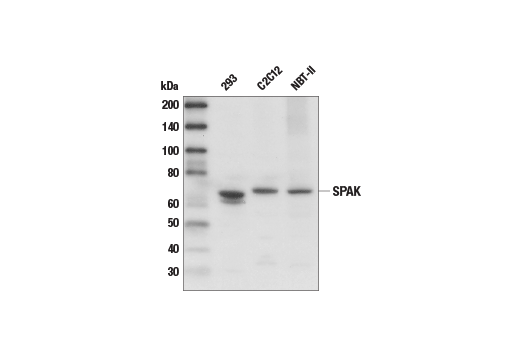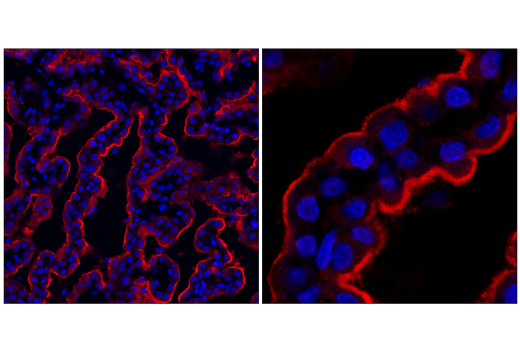WB, IF-F
H M R Mk
Endogenous
65
Rabbit
#Q9UEW8
27347
Product Information
Product Usage Information
| Application | Dilution |
|---|---|
| Western Blotting | 1:1000 |
| Immunofluorescence (Frozen) | 1:50 |
Storage
Specificity / Sensitivity
Species Reactivity:
Human, Mouse, Rat, Monkey
Source / Purification
Polyclonal antibodies are produced by immunizing animals with a synthetic peptide corresponding to residues surrounding Ser436 of human SPAK. Antibodies are purified by protein A and peptide affinity chromatography.
Background
SPAK (STE20/SPS1-related Pro/Ala-rich kinase) and OSR1 (oxidative stress responsive 1) are members of the GCK family of serine/threonine kinases. Overexpression and in vitro studies demonstrate that SPAK is able to activate p38 MAP kinase, indicating a possible role for SPAK in the stress response (1). Yeast two-hybrid screening revealed that SPAK and OSR1 bind to Na-K-2Cl cotransporters NKCC1 and NKCC2 and K-Cl cotransporter KCC3 (2). WNK1 and WNK4 phosphorylate SPAK at Thr243/247 and Ser380 (3-5). Similarly, WNK1 and WNK4 phosphorylate OSR1 at Thr185 and Ser315 (3,4). Phosphorylation at these sites stimulates SPAK and OSR1 activity, leading to NKCC1 phosphorylation and enhanced NKCC1 activity (3-5). SPAK is also phosphorylated at Ser311 by PKCθ in response to T cell activation. Substitution of Ser311 with Ala or specific siRNA knockdown of SPAK dramatically reduces TCR/CD28-induced AP-1 activation, suggesting SPAK is involved in T cell signaling as well (6).
- Johnston, A.M. et al. (2000) Oncogene 19, 4290-7.
- Piechotta, K. et al. (2002) J Biol Chem 277, 50812-9.
- Vitari, A.C. et al. (2005) Biochem J 391, 17-24.
- Moriguchi, T. et al. (2005) J Biol Chem 280, 42685-93.
- Gagnon, K.B. et al. (2006) Mol Cell Biol 26, 689-98.
- Li, Y. et al. (2004) EMBO J 23, 1112-22.
Species Reactivity
Species reactivity is determined by testing in at least one approved application (e.g., western blot).
Western Blot Buffer
IMPORTANT: For western blots, incubate membrane with diluted primary antibody in 5% w/v BSA, 1X TBS, 0.1% Tween® 20 at 4°C with gentle shaking, overnight.
Applications Key
WB: Western Blotting IF-F: Immunofluorescence (Frozen)
Cross-Reactivity Key
H: human M: mouse R: rat Hm: hamster Mk: monkey Vir: virus Mi: mink C: chicken Dm: D. melanogaster X: Xenopus Z: zebrafish B: bovine Dg: dog Pg: pig Sc: S. cerevisiae Ce: C. elegans Hr: horse GP: Guinea Pig Rab: rabbit All: all species expected
Trademarks and Patents
Limited Uses
Except as otherwise expressly agreed in a writing signed by a legally authorized representative of CST, the following terms apply to Products provided by CST, its affiliates or its distributors. Any Customer's terms and conditions that are in addition to, or different from, those contained herein, unless separately accepted in writing by a legally authorized representative of CST, are rejected and are of no force or effect.
Products are labeled with For Research Use Only or a similar labeling statement and have not been approved, cleared, or licensed by the FDA or other regulatory foreign or domestic entity, for any purpose. Customer shall not use any Product for any diagnostic or therapeutic purpose, or otherwise in any manner that conflicts with its labeling statement. Products sold or licensed by CST are provided for Customer as the end-user and solely for research and development uses. Any use of Product for diagnostic, prophylactic or therapeutic purposes, or any purchase of Product for resale (alone or as a component) or other commercial purpose, requires a separate license from CST. Customer shall (a) not sell, license, loan, donate or otherwise transfer or make available any Product to any third party, whether alone or in combination with other materials, or use the Products to manufacture any commercial products, (b) not copy, modify, reverse engineer, decompile, disassemble or otherwise attempt to discover the underlying structure or technology of the Products, or use the Products for the purpose of developing any products or services that would compete with CST products or services, (c) not alter or remove from the Products any trademarks, trade names, logos, patent or copyright notices or markings, (d) use the Products solely in accordance with CST Product Terms of Sale and any applicable documentation, and (e) comply with any license, terms of service or similar agreement with respect to any third party products or services used by Customer in connection with the Products.

